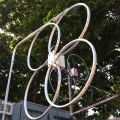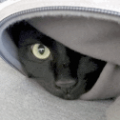G8JNJ
About
- Username
- G8JNJ
- Joined
- Visits
- 3,422
- Last Active
- Roles
- Member
- Points
- 400
Reactions
-
Antenna recommendation for listening to faraway DRM broadcast inside a city
Hi All,
Well the MLA-30 'sort of works' and it doesn't cost very much, so it's better than nothing for folks who don't want to build their own.
You get quite a bit for your money, and it's OK for use with say and RTL dongle in direct sampling mode, but I'll probably cry the first time I see one being used with a high end receiver like a Perseus or Airspy HF :-(
Here are some measured parameters of various popular loops using the same test setup.
MLA-30 OIP2 approx +46dBm OIP3 approx +20dBm
M0AYF OIP2 approx +75dBm OIP3 approx +27dBm
Wellgood (Copy of early Wellbrook) OIP2 approx +57dBm OIP3 approx +37dBm
LZ1AQ OIP2 approx +79dBm OIP3 approx +36dBm
I've now added the MLA-30 information, including circuit diagrams to my Active antennas webpage.
https://www.g8jnj.net/activeantennas.htm#MLA30
Regards,
Martin - G8JNJ -
Antenna recommendation for listening to faraway DRM broadcast inside a city
Hi All,
Well despite the rain I put the MLA-30 up in the air today.
It's a pretty poor performer, as the noise floor is about 20dB higher than any other active antenna I've tried, and increasing the amplifier gain doesn't help improve the Signal to Noise ratio.
There's also a lot of unwanted noise around 60 & 120KHz emanating from the DC-DC switcher in the Biasing Tee.
I've left it connected to one of my KiWi SDR's so that folks can try it for themselves.
http://southwest.ddns.net:8078/
You can use my other KiWi with a Loop on the ground as a reference.
http://southwest.ddns.net:8073/
Based on my tests, I wouldn't recommend it.
Regards,
Martin - G8JNJ -
Antenna recommendation for listening to faraway DRM broadcast inside a city
Hi All,
Well the MLA-30 'sort of works' and it doesn't cost very much, so it's better than nothing for folks who don't want to build their own.
You get quite a bit for your money, and it's OK for use with say and RTL dongle in direct sampling mode, but I'll probably cry the first time I see one being used with a high end receiver like a Perseus or Airspy HF :-(
Here are some measured parameters of various popular loops using the same test setup.
MLA-30 OIP2 approx +46dBm OIP3 approx +20dBm
M0AYF OIP2 approx +75dBm OIP3 approx +27dBm
Wellgood (Copy of early Wellbrook) OIP2 approx +57dBm OIP3 approx +37dBm
LZ1AQ OIP2 approx +79dBm OIP3 approx +36dBm
I've now added the MLA-30 information, including circuit diagrams to my Active antennas webpage.
https://www.g8jnj.net/activeantennas.htm#MLA30
Regards,
Martin - G8JNJ -
Bot appears on 517 khz with rapidly changing IP address
-
Antenna recommendation for listening to faraway DRM broadcast inside a city
Hi All,
I see that RTL-SDR.COM have mentioned the MLA-30.
https://www.rtl-sdr.com/reviews-of-the-low-cost-mla-30-wide-band-hf-magnetic-loop-antenna/
Best of all, on one of the sites mentioned Matt, M0LMK has boiled away the sealant goo and revealed the amplifier PCB. Well done :-)
https://www.m0lmk.co.uk/2019/09/12/inside-the-mla-30-active-loop-antenna/?fbclid=IwAR2G_OcFcLf5uAq8UqiTlXrw5NSpLQKrU-tWwGc_SUBFIcHj5PsSWeB5UKU
Speculation is that it uses a differential Input OpAmp/Line Driver such as a LMH6550.
Regards,
Martin - G8JNJ -
A question for the signal theory experts (Preamplifier gain)
>
>broadband magnetic loop, digital mode, there was no obvious advantage beyond about 3db (lowest) increase in noise floor
>
That's highly likely.
Glenn was spot on with his previous statement.
>
> It is more difficult to approach propagated and galactic noise floors with a small antenna, whether loop or dipole. It may not even be possible at mid-upper HF given typical >site signal levels and available active devices
>
With your loops and LZ1AQ amplifier, I suspect that the antenna performance is likely to be about 10dB worse than the sensitivity required to hear the galactic noise floor on the upper HF bands, so as soon as you see the noise from the amplifier raising the KiWi noise floor, you won't really notice any further improvement.
Very few (if any) 1m diameter active loops are capable of hearing down to the galactic noise floor on these frequencies, so it's not that you are doing anything wrong, it's just the laws of physics constraining things. There have been many previous threads on this subject if you wish to trawl back through them.
This is one of my gripes about Youtube videos where folks compare different receivers, but are using something like a Wellbrook loop as the antenna. In most cases the antenna is the limiting factor and not the actual receiver. In fact I despair about the trend with amateur transceivers where folks seem to gravitate towards equipment with very large dynamic range figures, whereas in all likelihood they will never be able to take advantage of it, because they are using compromise antennas in noisy urban environments. If you take a look at a lot of the KiWi's that are on line, many of them are struggling to achieve 20 or 30 dB dynamic range (max signal level to noise floor) for these reasons, so having a receiver capable of >120dB dynamic range is pointless.
I got close to achieving maximum sensitivity by using a combination of my TC2M broadband vertical, followed by a DXE-RPA1 copy 13dB low noise pre-amp and then a passive amplitude slope equaliser and selective BC band notches. By doing this I could have much greater RF gain on the HF bands, but roll it off on the LF bands where the natural noise floor was already higher than the KiWi baseline noise figure of somewhere around 14dB. However even this was not good enough to hear emissions from Jupiter at around 20MHz, which is what I was hoping for.
Regards,
Martin - G8JNJ -
A question for the signal theory experts (Preamplifier gain)
>
>broadband magnetic loop, digital mode, there was no obvious advantage beyond about 3db (lowest) increase in noise floor
>
That's highly likely.
Glenn was spot on with his previous statement.
>
> It is more difficult to approach propagated and galactic noise floors with a small antenna, whether loop or dipole. It may not even be possible at mid-upper HF given typical >site signal levels and available active devices
>
With your loops and LZ1AQ amplifier, I suspect that the antenna performance is likely to be about 10dB worse than the sensitivity required to hear the galactic noise floor on the upper HF bands, so as soon as you see the noise from the amplifier raising the KiWi noise floor, you won't really notice any further improvement.
Very few (if any) 1m diameter active loops are capable of hearing down to the galactic noise floor on these frequencies, so it's not that you are doing anything wrong, it's just the laws of physics constraining things. There have been many previous threads on this subject if you wish to trawl back through them.
This is one of my gripes about Youtube videos where folks compare different receivers, but are using something like a Wellbrook loop as the antenna. In most cases the antenna is the limiting factor and not the actual receiver. In fact I despair about the trend with amateur transceivers where folks seem to gravitate towards equipment with very large dynamic range figures, whereas in all likelihood they will never be able to take advantage of it, because they are using compromise antennas in noisy urban environments. If you take a look at a lot of the KiWi's that are on line, many of them are struggling to achieve 20 or 30 dB dynamic range (max signal level to noise floor) for these reasons, so having a receiver capable of >120dB dynamic range is pointless.
I got close to achieving maximum sensitivity by using a combination of my TC2M broadband vertical, followed by a DXE-RPA1 copy 13dB low noise pre-amp and then a passive amplitude slope equaliser and selective BC band notches. By doing this I could have much greater RF gain on the HF bands, but roll it off on the LF bands where the natural noise floor was already higher than the KiWi baseline noise figure of somewhere around 14dB. However even this was not good enough to hear emissions from Jupiter at around 20MHz, which is what I was hoping for.
Regards,
Martin - G8JNJ -
Need to attenuate LW 252 Khz
>
> found that the notch was 34 dB deep, which was more than necessary. I 'softened' it to 20 dB with a series 2.2 ohm resistor.
>
Hi Richard,
That's good, you must have found an inductor with a good value of Q.
I've only ever been able to achieve a maximum of about 20dB using surface mount or small molded axial types.
You can widen or narrow the notch bandwidth by choosing different L/C ratios. The values I used were designed to provide some attenuation over the whole of the LW BC band, with a deep notch at the band center and minimal effect outside of the band (148-284KHz @ -3dB).
You can decrease the depth of the notch by adding low value series resistors as Richard suggests. When using surface mount inductors, I typically add 6.8 Ohms to this circuit to obtain a notch depth of 10dB, with 0 Ohms I can get about 17 to 20dB.
Here's a plot showing the measured performance of my BC band filters.
Regards,
Martin - G8JNJ -
Need to attenuate LW 252 Khz
Hi Mark,
Here's a simple notch that should do the trick and give you a 20dB deep notch on 252KHz.
It's just a series tuned circuit wired across the antenna feed into the KiWi.
You may need to fine tune either the inductor or capacitor value to get it spot on frequency, but these values should get you close.
If you buy a standard value pre-wound inductor, just play with parallel combinations of capcacitors to get near the correct value by watching the KiWi S-meter when tuned to 252KHz.
Regards,
Martin - G8JNJ -
Channel Button
Hi Stu,
This is an interesting idea, but it looks a bit cumbersome (if I understand what you are proposing correctly).
I wonder if another method would be to allow users to navigate by 'stepping' through the displayed DX tags.
If you then used the @ menu to filter the tags by name, it would allow you to select say just tags with 'CB' and then you could simply step up and down the tagged channels, perhaps perhaps using something like the left and right had arrows to select 'next' and 'previous' as would be the case using a Windows word search in a document.
This would also be useful feature for marine & aero channels among others, assuming they were tagged correctly.
Regards,
Martin - G8JNJ




